Day 1: A 20 Rupees “Special Fruit Juice” and many hours later, the bus bit the asphalt of National Highway (henceforth NH) Number 9, through the northern tip of Karnataka and into Maharastra. Somewhere between Sholapur and Bidar, there was the ceremonial dinner halt, where all the tourists scrambled out to take a leak and grab a bite to eat. A few cigarettes and a 92 Rupees meal of Chicken and Roti with Curd later, the bus was off to Sholapur and beyond. Here came the first lesson of intrepid travelling: Thou shalt not eat non vegetarian food from overpriced roadside dhabas. A veg curry could have easily saved a good 50 bucks, and would have been a safer bet, in terms of hygiene. Oh well, the deed was done, and that was that.
Day 2 saw the first golden rays of the morning sun across the horizon near Belgaum. The AC inside the bus was set beyond the ‘it’s so cold my privates are frozen’ point, which ensured a good night’s wakefulness. Around 63 km from Panaji city, another dhaba, another stop- only this time the Hipposaur was on his guard. The damage was restricted to a single cup of tea (Rupees 6), bought from an old guy with a shiny silver ponytail. You could almost sense that Goa was nearby. The people became friendlier, and their appearance gradually morphed to retro. After landing at Mapuca, the obligatory phone call home was made from one of those little red telephones where you put in 1 Rupee coins. (Rupees 5), followed by a local bus ride (Rupees 6) to Calangute, where the Hipposaur planned to put up for the next few days.
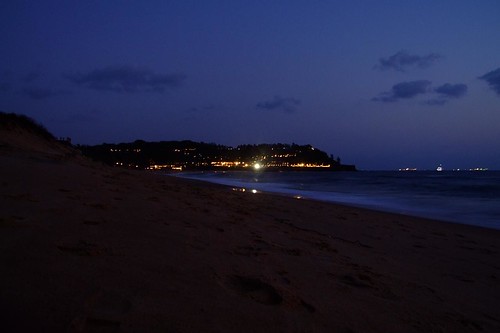
Upon arriving at the main crossing at Calangute, a bit of hunting around yielded the golden pathway to the Tourist Lodge, where magical dormitory beds awaited with the promise of cheap rates. Luckily for the Hipposaur, this was the onset of the low season for tourists, so beds were availed at Rupees 130, including taxes, per night. However, there was a teeny-tiny problem: Since these were only dorm rooms, there would be no advance booking, so if a large group of tourists were to arrive at some point, who might want the dorms for their chauffeurs and whatnot- he would be given the boot! In any case, if you want to know more about dormitories under the GTDC, visit them at:
www.goatourism.org
The Hipposaur, at this point was quite sleepless and desperate, moreover the room seemed pretty okay, and so it seemed a fair deal. A word of advice here, though: don’t expect too much service or politeness from the GTDC staff if you’re putting up at the dorm, basic things like towels and change of sheets can take quite a bit of begging and pleading. The loos aren’t too clean, no mirrors, but has a shower, which means you don’t have to worry about dirty buckets and mugs .As an added plus, there’s a water cooler with an ancient purification contraption, meaning you can save up by not buying bottled water for day trips.
Meanwhile, the journey and the air condition of the bus obviously had far reaching effects on the Hipposaur’s rather impressionable mind, for he promptly booked a ticket for a tour of South Goa, two days later. This was, by any measure of intrepid travel, the stupidest, most ridiculous and irredeemable error one could commit while backpacking across Goa. The Hipposaur was doomed, fated to be packed like sardines in a can of a bus with a sweaty, possibly obese tour guide babbling away stuff that you might already know…absolute horror. Anyway, by the time this essential realisation hit him, the deal was done, and a crisp 160 Rupees handed over to the bored, middle aged, Marathi clerk at the reservation counter in lieu of the trip. To recover from the impending doom of touristy travel, our Hipposaur decided to explore around a bit, and take a dip in the sea while at it. This posed a problem for the young traveller, whose brain was obviously getting fried by the 38 degrees of sunshine. Since he was travelling alone, there was the possibility of sandals/towels getting stolen from the busy, busy beach of Calangute. The Hipposaur’s high myopia only added to the problem. The only way out was to keep these things secure was to deposit them in a nearby shack, for some money. Not willing to be ripped off by the evil shack owning mutants, our young hero decided to do something entirely unnecessary in the blazing May heat of Goa- He kept his sandals, shirt, wallet etcetera in the dorm room; retaining only a set of spectacles and a pair of shorts, walking barefoot through the ½ km stretch of searing asphalt between the tourist lodge and the sea. Innumerable curious stares, three blisters and a bruise later, the ocean welcomed him. After a nice loooong shower back at the lodge, a rumbling stomach beckoned the weary soul to get hold of some lunch. Down the beach at the Candolim-Calangute border, a shack with no name was discovered, owned by some guy called Jerry or Francis (can’t remember). Lunch was a plate of Rice (25 Rupees), with Chilli Fry Sausages (80 Rupees), all washed down with a chilled bottle of King’s Pilsner Beer (40 Rupees), to be elaborated on, later. The sausages were made of lean pork, marinated in all-too-much palm wine vinegar, cooked with capsicum peppers, onion slivers and chilli flakes, edible, but nothing to write home about. Now the beach shacks are one of the most touted items on the tourists’ “to do list”. These are, in essence, gaudy temporary structures with remixed hindi/Vengaboys type numbers blasting from loudspeakers, exhibiting a mix of Indianised Rasta-décor and sheer tastelessness. Of course, all this while they succeed in burning a hole in your pocket, as well.
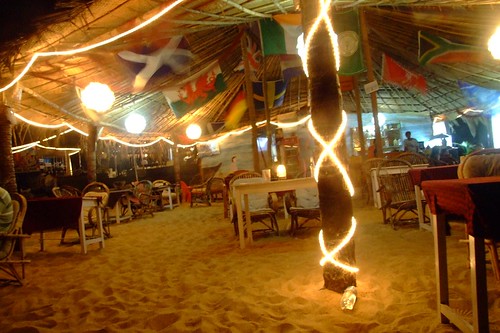
After lunch the Hipposaur boarded a local bus to Mapuca (8 Rupees) and took a stroll through the central supplies market. There you had your regular fruits and vegetables and general ‘kirana’ type stores, nothing remarkable, except for the odd spice vendors sitting at regular intervals through the market square, ensuring a steady waft of star anise and vanilla. Some Anise was purchased from an old lady (Rupees 30 for 250 grams) and the hunger resurfaced. Tea and ‘pav’ bread was bought from Chai Corner near the bus stand (Rupees 5), followed by a surprisingly filling and tasty chicken Shawrma Roll (Rupees 20) from a corner near the bus terminus. The evening bus to Calangute was relatively empty (Rupees 7) and landed at Calangute after half an hour, cutting across sleepy hamlets and lush green fields of paddy. Upon reaching Calangute, the market was bustling with tourists and autorickshaws. Manna from heaven appeared in the shape of what may be the best watering hole in all of Calangute – The Public Bar.
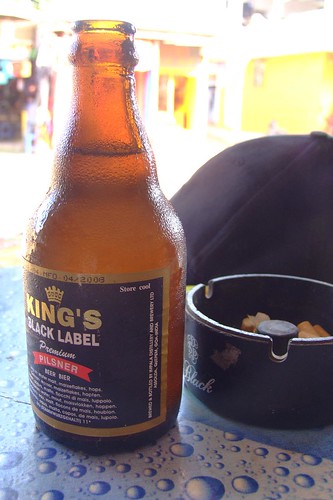
The Hipposaur dodged pedestrians and nosedived to the front porch of the bar counter. A fabulously chilled pint of King’s helped soothe his tired limbs. A good hour later, the Hipposaur sniffed out the unmistakable aroma of fried pork, which was traced to an ancient Portuguese structure-turned restaurant: Sossegado de Souza, just off the road between Aguada and Calangute, close to the Calangute crossing.
A fantastic dinner of Rice (Rupees 25) and Pork Sorpotel (Rupees 70) followed. The sorpotel consisted of pork liver and fat cooked in a thin sauce of tomatoes, garlic and spices, all tempered with vinegar and the local brew made of Cashew- the inscrutably potent Feni.
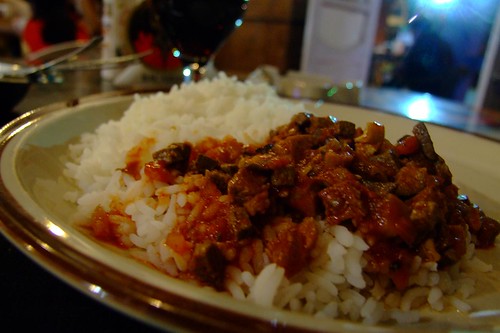
The regal feast was washed down, quite appropriately, with a glass of fine port (Rupees 25). After a lazy stroll through the windy central square, the grainy, discoloured bed sheets of the tourist lodge lulled the Hipposaur to sleep.
Day 3: Never one to see the rising sun, the Hipposaur surprised himself by waking up at 6:30 am. A stroll down the road to the market led to a small hole-in-the-wall joint (Sarvesh Café) on the side of the road, where the Hipposaur sauntered in for a typical Western Ghats-style breakfast of pav, tea and eggs (Rupees 9). Back to the lodge and the Hipposaur makes an arrangement with the reception manager to extend his stay for another 2 days. An advance payment (Rupees 260) is made in this regard, with a quick warning from the manager indicating that the room must be vacated after two days. This meant that after two days, the Hipposaur needed to figure out another place to bunk in. Fair enough. Ergo, a quick shower in the common dorm loo (without mirrors) was then followed by a quick walk to the bus stop. The Hipposaur then boarded, backpack and all, on a biggish bus headed for Panaji (Rupees 10), which played loud Hindi music. Incidentally the bus conductors use a complicated system of whistles to direct the bus to stop to go: A brief whistle for stop; and a more elaborate “peewooeeeep!” whistle to go, all in all fairly entertaining.
The bus stopped at the KTC Bus Terminus (that’s Kadamba Transport Corporation), located, rather conveniently close to the Ourem Creek in north Panaji. A walk down the Pato Bridge took the Hipposaur down to the Old Portuguese quarters of Fontainhas.

The architecture of Fontainhas was simply put, breathtaking. Every which where one looked, there would be these pretty buildings painted in bright hues of blue/white or ochre/white, carrying forth the tradition of repainting the vivid walls after every monsoon.

These houses were either stacked across narrow serpentine lanes or set against manicured streets with ornate lamps lined across the creek. The rows of trees that bordered the roads would stretch to the distance, as far as the eye could see. Once in a while, the buildings would house quaint shops with ornate signboards in Portuguese. While strolling through the lanes and by lanes around the market the Hipposaur picked up a pack of locally made ‘Kerala style’ sugary coconut halwa (Rupees 35) that would serve as a fairly filling energy snack over the next two days. After quite a bit of hunting around, a cyber café is discovered (Rupees 20), and a quick map of Panaji is sketched out in the ever-present writing pad. The Hipposaur narrowed down two possible options for putting up at Panaji after his tenure at the Tourist Lodge expires- either of the two youth hostels located near Miramar and Dona Paula. With grand plans of staying in a 50 Rupee dorm with the sea breeze blowing through the youth hostel window, the Hipposaur hopped in a bus to Dona Paula (Rupees 5).
After a 1½ km walk to the island of Dona Paula, the blazing afternoon sun ensured that by now, the Hipposaur was d-r-e-n-c-h-e-d in sweat, with a 20 pound pack strapped on his back (Of course staying in the dormitory meant that you do not leave anything in the room, except for maybe your slippers). The Dona Paula Hostel turned out to be completely booked for the next few weeks, which means another bus ride back to Miramar. The Miramar Youth Hostel is located, conveniently near the Campal-Marriot bus stop, right beside the Mandovi bay. In terms of location, you cannot get a better deal in Panaji, which only implies that the hostel is perpetually booked for months. This apprehension was not too far from the truth, as the Hipposaur was informed that only an AC double bedded room was available, for 350 Rupees- which, if you know your Goa, translates into a bloody good deal. Nevertheless, our intrepid wannabe decided to play it risky and not book anything in advance- a move that ultimately had it own peculiar rewards. If you do want cheap rooms in Goa, the Youth Hostels in Miramar and Dona Paula are a good bet. It’s always a better idea to book a dorm beforehand, you can contact them at:
Youth Hostel (Miramar)
Beside SAI Complex, Marriot-Campal bus stop,
Miramar, Panaji, Goa-403001
Tel: 91-832-2225433
Youth Hostel (Dona Paula)
C/o Sea View Hotel,
Building next to Dona Paula Police Station
PO: National Institute of Oceanography
Dona Paula, Tiswadi, Goa – 403 004
Tel: 91-832-2453427, 2515690
http://www.yhaindia.org/
After a light lunch of an olive and lettuce salad in garlic vinaigrette (Rupees 60) from Edu’s, placed on St. Inez, opposite the SAI Complex, the Hipposaur walked back to Panaji market.
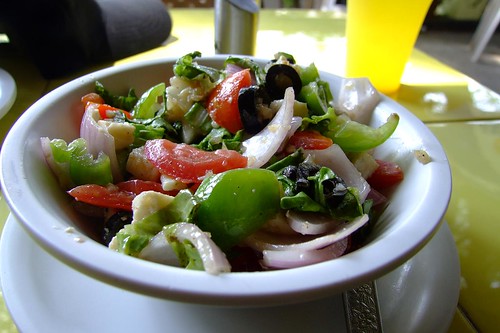
There he saw this old lady (there are many old ladies in Goa, evidently) selling this clear fluid in booze bottles.
Half hoping that the fluid be araq (Palm distilled brew), our sweaty traveller was told that it was fresh…coconut oil! The price seemed reasonable, so the Hipposaur picked up a nip bottle for 20 Rupees, for future use in hair-care. Oh well.
A walk down the pretty road along the river Mandovi led the Hipposaur back to the bus stand, where he hauled a bus back to Calangute (Rupees 10). At the tourist Lodge, our young and wary traveller, after taking out his camera and money, locked up his sole backpack and discreetly pushed it under the bed into a corner where nobody would see it. A 15 minute break later, he was back on the beach, walking in the general direction of the Aguada Fort in Sinquerim.

From the Sinquerim beach he saw the giant frame of the Russian Carrier MV River Princess, stuck on the shallow waters like a beached whale. Meanwhile the sun had set, ergo: thus far and no further for the day. While walking back, the Hipposaur detected the onset of cramped feet, thus a place to rest was found, in Jolly Jack, a beach shack playing host to a bunch of foreigners and a few Indian tourists. Here, the Hipposaur rested for a good 40 minutes, nursing a cigarette (Match box purchased earlier for Rupee 1) and an icy pint of King’s. The food was v-e-r-y pricy, so dinner was postponed until Calangute. Lesson of the day: Beach shacks are extremely over rated, and must be avoided if you want to save some moolah, in Goa. Upon reaching Calangute, the Hipposaur found himself drawn magically (we suspect he was too lazy to explore at this point) to Sarvesh Café, where, for a sum of Rupees 30, dinner was served. The meal consisted of Fish Curry-Rice, which was basically Two small pieces of mackerel coated in batter and deep fried, served with a coconut based curry, and a side of veggies and super spicy egg-bhurjee, which literally charred the Hipposaur’s formidable stomach lining. A tiny bowl of reddish clear fluid timidly made its appearance on the table. Upon enquiry it was solemnly told that “This is good for you, drink it.” The Hipposaur, paranoid creature that he is, slowly drank the rather sharp liquid. And Lo! In a minute the burning in his stomach ceased. The mysterious solution was henceforth christened the red fluid of magic, as the waiter gave a look, which may only be translated as “Told you so”.
Day 4 was the day of the much dreaded ‘packed like sardines’ South Goa Tour, booked earlier. Hoping to catch the tourist bus on time, the Hipposaur started off with a quick breakfast at Sarvesh Café, consisting of lovely fluffy white parotas and peas bhajji. In a bid to be experimental, our traveller ordered a side of yellow halwa that adorned the glass case beside the cash counter, along with a regulation cup of tea. The parota-bhajji was absolutely wonderful; the halwa that smelled of kerosene was a nice contrast. Not one to be deterred by such minor olfactory aberrations, the Hipposaur wolfed the whole deal in 10 minutes flat, at a damage of Rupees 24. After a quick shower, he waited for the bus (that was filled to the brim with at least 47 hysterical Bengali and Gujarati tourists), which arrived on time. However, at the very last moment, the intrepid traveller realised that he had forgotten to fill up his water bottles from the cooler. After telling the driver to wait (who smiled and nodded in agreement), the Hipposaur, with amazing dexterity, filled 2 litres of water in 1:26 minutes. But to his dismay…the bus had already left! Immediately the receptionist was called and the situation explained. After a set of apologies, the Hipposaur was told that the driver in question had apparently not understood a word of what he had said, his comprehension being limited to Konkani and Marathi (neither of which the Hipposaur spoke, nor understood). Oh well, the tour was then rescheduled to a date two days later, and the Hipposaur walked off, devising the change of plans for the day, passing by backwater forests and fishing villages. In a while, he hopped on to a bus headed for Candolim (Rupees 4) and reached the Sinquerim crossing. A right turn took you to the lower ramparts of the Aguada Fort, at a distance of 1 km, while the left turn would lead to a 3 km uphill road to the upper Fort. After taking the right turn, a downward sloping avenue with trees lining the sides took the Hipposaur to the lower Fort.
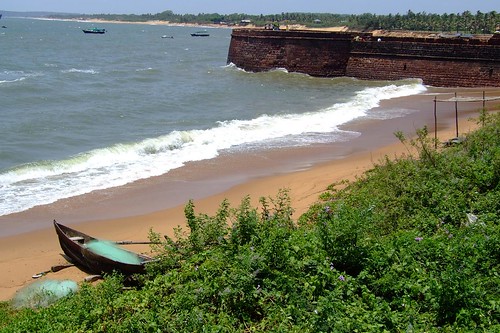
Now for a bit of History: The Lower Fort served as a safe berth for Portuguese ships in the 17th and 18th Centuries, with a single bastion extending into the sea. The Upper Fort has a gigantic 23,76,000 Gallon reservoir for storing fresh water, along with a lighthouse for navigation that was decommissioned after 1976.
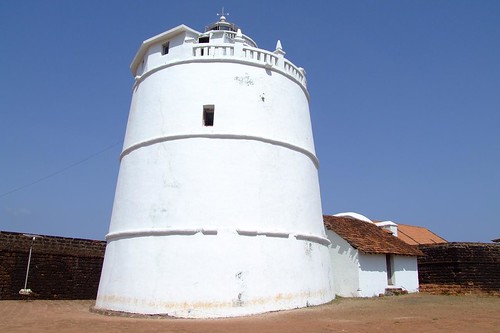
From the Sinquerim crossing the left turn takes you through a steep climb, which the Hipposaur now intended to accomplish, backpack et al. The hike takes you through a tree lined road with the blue green backwaters on your left, which curves to the right around the hill till you reach the top.
40 minutes later, the Hipposaur was found loitering around the Upper Fort, with the old lighthouse painted white, set against the cloudless blue sky as it merged with the ocean far away. Unfortunately the inner chambers of the Aguada Fort are sealed shut by the ASI with metal grilles, so one must be content in exploring the massive top level, which offers a panoramic view of the Mandovi Bay. On the way back, near the Sinquerim bus stand, a smallish eating joint was found, called Konkan Bhuvan. Now this was not your typical restaurant, mostly catering instead, to tourist cab drivers and local folk. ‘Excellent!’ reckoned the Hipposaur. A plate of Fish Curry and Rice (Rupees 30) and pint of Kingfisher (Rupees 25) was ordered, upon which a large plate arrived in a while. The plate consisted of rice, a cabbage and potato curry, pickles, a seasonal salad of beetroot and cucumber, a large, batter coated, deep fried, whole mackerel, curry and a bowl of the red fluid of magic.
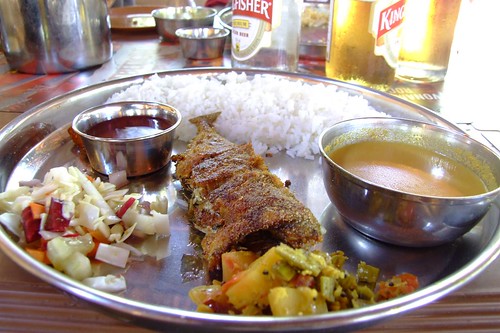
Later, extra rice was ordered (Rupees 5) that had two slivers of fish on the top, as an added bonus. This time around, the friendly owner patiently explained that the red liquid was in fact juice extracted from the kokum fruit, mixed with amchur and coriander leaves, which aids in digesting all that spicy food.
Having thus solved the mystery of the red fluid of magic, the Hipposaur marched on towards the bus stand, and climbed on a bus to Calangute (Rupees 5), with specific intentions of moving further north towards Anjuna, to see the flea market. The plan was foiled, of course, by his laziness, as he dropped like a fly the moment he entered the dorm and sunk into a deep slumber. As evening settled over the horizon, the Hipposaur failed to catch the 7:30 bus to Anjuna, meaning that the flea market would not happen. Dejectedly, he then traced his steps to the Public Bar, and rested with a chilled pint of King’s Pilsner (Rupees 25). Which is kinda interesting, as an aside, the fact that Goa shuts shop by 8:00pm, transport and all, so you can get only a few hours in the morning, and a few more in the evening for shopping and travelling by buses. The afternoos, of course, accounts for the inscrutably Goan ritual of siesta, an afternoon nap, that no true Goan would do without.
This was his last night in Calangute, as he would be chucked out of the Tourist Lodge by noon, the next day. Two bottles of San Andre Coffee Liqueur were bought (another dumb move, since Panaji had lower booze prices) (Rupees 340). A lazy walk along the Baga-Calangute connecting road led to a small stall selling bongs and pipes of various kinds, ergo, the purchase of a splendid white ceramic bong (Rupees 125, after a lot of haggling from the original price of 350). Feeling rather tired after all the hiking around in the blazing sun, the Hipposaur decided to try out one of the fancier looking places close to the beach. The restaurant, named Capricorn, was an open layout affair, with old reggae numbers playing in the background. In no time, impeccably dressed waiters served generous helpings of Basmati Rice, Pork Vindalho cooked to perfection with just the right edge of spice and a hint of vinegar, steaming sausage chilli fry finished with crunchy veggies and a glass of coke (Rupees 250 including tip). Feeling happy and full, the traveller strolled to the market, picking up a pack of the ubiquitous Wills Flake cigarettes (Rupees 19) and retired for the night.
Day 5: After waking up around 7:30 the Hipposaur suddenly remembered that this was the day of the dreaded South Goa Tour. Not willing to face embarrassment for a second time, he quickly bathed, filled water and stuffed his backpack. He checked out of the Tourist Lodge, and boarded the rather small tourist bus, all raring to set out for the day-long ‘South Goa Tour’. This meant that at the end of the tour, around evening, he would have to find accommodation somewhere in Panaji. Good enough. The bus, thankfully, was not full of 47 hysterical Bengali and Gujarati tourists, but a small bunch, around 12, of middle aged good Christian aunties and uncles, all hailing from Mumbai. The Hipposaur silently thanked his lucky stars. The bus sped along the state highway and crossed the Mandovi towards Old Goa. First stop: Basilica of Bom Jesus, which was a splendid basalt and sandstone structure, housing the mortal remains of St Francis Xavier. Apparently, this is one of the richest churches in Goa and is carpeted with marble flooring and inlaid with precious stones. The tomb was carved by the 17th century Florentine sculptor Giovanni Battista Foggini. The casket containing his body is made of silver and lined with glass, set in rich Baroque style. Across the road leads to Se Cathedral, dedicated to St. Catherine of Alexandria, an enormous white structure and one of the largest churches in Asia. The cathedral was built to commemorate the victory of the Portuguese under Afonso de Albuquerque over Adil Shah’s army. Since the day of the victory happened to be on the feast of Saint Catherine, the cathedral was dedicated to her. It was commissioned to be enlarged in 1552 on the remains of an earlier structure. The Cathedral was finally completed in 1619 and was consecrated in 1640.
As the day rolled on, the bus stopped at many temples and skirted past beaches lined with palm trees. The Konkani temples have, in due course of time, absorbed some of the western architectural influences, resulting in some very interesting red and ochre structures that are a blend of Greco-Roman, Portuguese and Hindu styles. Next up was the beautiful old town of Margaon, where the tour bus stopped for a lunch break. The Hipposaur utilised this break to explore around the town square and stumbled upon the most wonderful place for authentic Goan food- Longuinho’s.

The flaking wooden signboard in Portuguese welcomed you into a hustle bustle of waiters running about, and local folk chatting over lunch and a few beers. In less than 20 minutes the Hipposaur polished off delicious ham sandwiches and fried spicy Goan sausages (called Chouricos) over a pint of Bud (Rupees 110 including tip). After the satisfying meal, back to the bus and off to Colva beach for another pint of beer (Rupees 25).
Then the Hipposaur got dropped off at Dona Paula after coursing through some more sleepy little villages and acres upon acres of lush green paddy.

At Dona Paula, he decided to hike to the Raj Bhawan, a nice red building, and present residence of the Governor of the State of Goa.
A couple of rather stupid Europeans with bruised knees were spotted, trying to handle a two-wheeler, with little success. Then the Hipposaur realised that these two were completely drunk, so he decided to walk away, wishing them all the success in their discovery of “the real India”. Idiots…these obnoxious, arrogant and overweight people come down to Goa, thinking they are making some kind of Kerouacian trip of self discovery, and end up buying silk screened tee shirts with “Hin-doo” calendar motifs, some overpriced glass beads and smoke second-grade marijuana. They end up looking like those white-skinned extras employed in the B-Grade Bollywood spy flicks from the 70’s. “Well, congratulations on getting to know our great land of snake charmers, mosquitos and soft drugs. We’ll send you your medal of bravery and tee-shirt, for surviving the subcontinent!!” Oh well.
On the way back, a path to the right led to an old British cemetery in ruins, which was quite pretty, as it lead down to the sea far away. From there the Hipposaur hauled a bus to Campal (Rupees 5) and then walked till Panaji market as the sun set across the Mandovi Bay. After making a few calls (Rupees 29) he decided to explore the area between Fontainhas and Panaji market. After crossing the Church of Immaculate Conception, a lodge was found nestled in a by lane, called 31st January Road, on Sao Tome, that led to the main road near the post office. The lodge in question was little more than a set of 4 feet by 8 feet rooms and a few slightly bigger double bedded rooms.

After some haggling, the rent for one night was narrowed down to 150 Rupees for a single 4 by 8 cell of a room. Not bad for a private lodge in a prime locale like Sao Tome, where the riverfront was a mere 30 second walk away. Towards the evening the Hipposaur walked about the road lining the Ourem creek and bought a bunch of things for friends.
Bebinca, Squid Pickles and packeged Balchao (Rupees 180) was bought from a shop at the Fontainhas-Sao Tome crossing, while a bottle of Liqueur (Rupees 150) was picked up from a lovely place with a friendly owner, called Tom’s, near the municipal square. After sunset, the Hipposaur got a bit peckish and hunted out a bit of a snack in a small shop called Kitchendom Cafeteria, between Rue d’Ourem and the Income Tax Office. This food joint is owned by a very friendly man of Indo-Portuguese descent, Erasmos Fernandez, who will talk to you and is willing to provide interesting help and advice, would you ever need it. The food is again, a typically Goan-Christian affair, consisting of beef chops: tender mince lightly seasoned and coated in mashed potatoes, lightly crumbed and fried, meat samosas: mince in a patty like envelope, and a fairly popular concoction called Chilly Fry Bread, which is basically a far superior version of Beef Chilly Fry, stuffed in a pav bun(Totalled at Rupees 44).
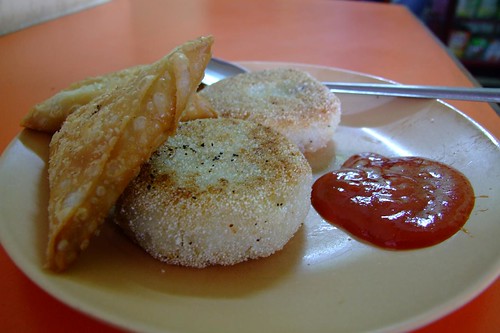
The lesson of the day: The town joints make far better Chilly Fry than the overpriced beach shacks, which invariably end up serving milder, bastardised versions of the local food, more suited to the touristy palate. If you ever want the low-down on authentic spicy Goan food, hit the small eating joints about town, and limit your beach shack ‘experience’ to a pint of beer. As night fell, another walk around town and dinner was sniffed out from a hole in the wall operation called Ritz Café, opposite Hotel Aroma, consisting of shark Ambor Tik: melt-in-your-mouth chunks of tender shark meat cooked in a velvety gravy of tomatoes, chilli, garlic and coriander, accompanied by rice, veggies and pickle (Rupees 75). The eating joint was a small corridor lined with a set of tables, and waiters scurrying about, very busy and very chaotic. Don’t expect to be waited upon, just holler out your order! Their sea food menu is extensive, and the food is fresh, much recommended. After a very filling meal, the Hipposaur walked down the brightly lit streets around St. Inez, resting occasionally to smoke and watch young boys fishing on the sly with makeshift tools, sitting by the darkened banks of the Mandovi, as the black waters slowly flowed by.
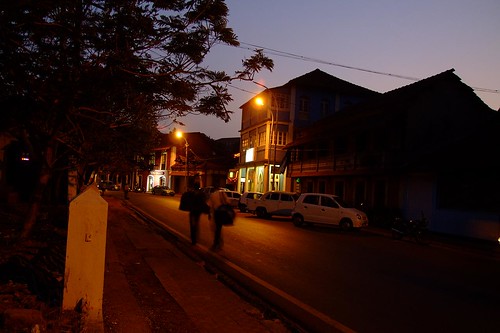
Day 6: Walking up mildly dehydrated, the Hipposaur proceeded to take an early morning dump, when he realised that the bathrooms had no roof! Oh well, 5 minutes later, he was done and off to pick up breakfast. The Kamat hotel, a chain of South Indian food joints, provides clean and hygienic vegetarian food, hence a safe bet before heading out for the 16 hour ride back home. A plate of Idlis and a cuppa filter coffee (Rupees 20) later, he was back to the lodge, where a quick shower ensued in the bathroom under the sunny sky. No complains here. He checked out from the hotel and hit the sunny streets of Panjim.
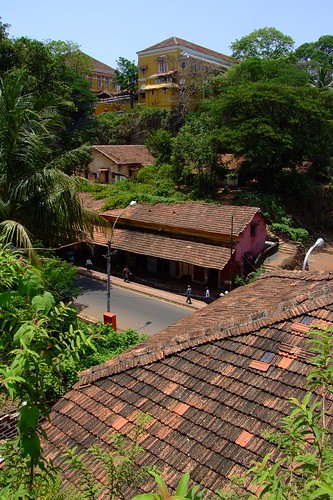
After loitering about aimlessly for an hour or so, he found himself in the front porch of Erasmos’ little shop near Rue d’Ourem. Brunch consisted of two delicious and filling beef chops and a coke (Rupees 24), along with a takeaway of two beef chilly fry breads (Rupees 40). After bidding adieu to the ever-friendly Erasmos, the Hipposaur walked back to the narrow lanes of Fontainhas to reach the whitewashed Chapel of St. Sebastian, tucked away in a little corner behind the Panaji Church. After walking about in the lanes lined with yellow houses, for a couple of hours, the blazing sun called for some chilled beer. Ergo, lunch at George’s restaurant.

A fairly elaborate fare was ordered, consisting of sweet-sour Pork Balchao, accompanied by Beef Pulao and a pint of Bud (Rupees 180 including tip) The Balchao was seeped in a rich and tangy gravy of tomatoes and vinegar, while the Pulao emerged a real winner, generous helpings of basmati rice cooked with tender chunks of braised meat, delicately flavoured with a hint of cinnamon. Absolutely divine! The ambience of George’s was a real treat, with simple, no frills furniture, and waiters dressed in red, exuding sheer Goa-ness in every nook and corner. The place gets pretty crowded around lunch time, so make sure you get in early, and relax with a Bud before your food arrives, soaking in the ambience, as old Dire Straits tracks play from the overhanging speakers, softly enough to hold a conversation.
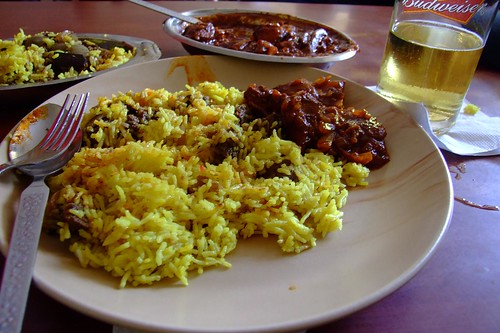
After lunch, the Hipposaur crossed the Pato foot bridge and explored the northern part of Panaji. After checking emails (Rupees 20), taking a piss (Rupees 2), the Hipposaur walked back along St. Inez and dropped in to pick up some tiny bottles of spirits, and a couple of bottles of Goan port (Rupees 180). As the sharp tang of the sea breeze hit him while he walked along the Mandovi, the Hipposaur took one last, long look at the pretty yellow buildings dotting the avenue, as shady trees lined the stone-paved footpath along the river. While boarding the bus that would take him home, the Hipposaur mused, travelling alone was a paradox of sorts: You are free to do whatever you want, when you want, and to go wherever you want to; yet it entails responsibility and a considerable degree of alertness, always being aware of one’s belongings, IDs, Camera, money etcetera. It was this dual nature of travelling solo that makes it all the worthwhile. The Hipposaur would never regret meeting all the wonderful people in his journey, and all the wonderful images that would be etched in his mind for a long, long time.

10 comments:
Hipposaur, you've caught the essence of solo travel there. The fun of it is always that you end up being so much more immersed in everything around you, because you just can't help it, and the terror is always that you could lose your precious belongings (which is why precious belongings should be kept to a minimum) or be ravished against your wishes by amorous and more powerful hipposaurs or, er, break your leg.
The food pictures are very hungry making. :) And ho excellent that your discovered that the secret of eating in Goa is NOT to eat at the beach!
How come no Old Goa?
I think I love your blog most because of all the food photos...:)
They inevitably leave me hungry...
Checked up the photos mostly this time.. it's a long read so will read it up at leisure later. My best ones are 'Stretch', 'Rue d'Ourem by night', 'By-lane'.
Oh how lovely! this is good stuff O Hipp. Much fun must've been had. and food and fun. The pictures are delectable...:)
Ah, you make me both nostalgic and envious. Great pictures and good writing. Really enjoyed it. And I second Scribbler on how you captured the 'traveling alone in goa' vibe.
Cheerios!
Gagu
p.s. Make space for anonymous or nom de plume comments no :)
oi!
got so hungry reading your post...
and i was waiting for comments on europeans ;)
nice work!
the updated versions better. hows it goin?
Uncle, uncle, I am hungry, please eat some food and post pictures, no?
Nicely written travelogue, I chanced upon your blog rather accidentally and was captivated for the next half-hour, your detailing is so vivid and precise it sketches real images of the places in the reader's mind. I might travel to Goa sometime in the near future and shall definitely use your blog as a dependable reference for the best places to eat and stay.
Hey thanks a lot Rono! You know what they say, can't stop a Bong from travelling!
Very nice blog post you have shared here thank you very much for posting such kind of blog post.
Bike Rental in Goa
Scooty On Rent in Goa
Bikes On Rent in Manali
Bike Rentals in Candolim
Post a Comment